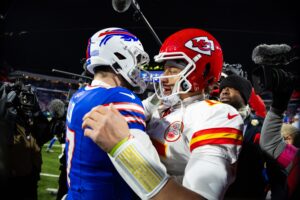The best, worst, most complacent, awful, happiest, tragic, relieved, even more tragic, and then utter disappointment of moments was had on Saturday afternoon. Taking a step away from this game, and the Tennessee Titans beating the Kansas City Chiefs in utterly wild fashion was an NFL playoff game for the ages, shattering expectations and crushing hopes as if the universe was capitulating some dreadful hate on the Chiefs organization. The truth of the matter is that the Chiefs capitulated that disgusting play on their own heads. They dictated, manipulated, and paved their own chains of death in a tale of two halves, two strategies, and two contrasting Chiefs units observed throughout the entire season.
Giving up the game after leading 21-3 was a perfect microcosm of all the Chiefs woes on the season, emblematic of a second half defense wholly bereft of purpose. The perfect irony of the situation may be put in the succinct data line that the Chiefs ran 21 offensive plays the entire second half; 21 plays that wasted perfect opportunity. And to add even more pain on the situation, the Chiefs at one point were in the 95-percentile bracket of control on the game. The Kansas City Chiefs wild card stats reveal off-season implications and a historic disaster, but for the moment, left an unfinished painting on the field, with only dreams of that which could be.
Kansas City Chiefs Wild Card Stats and Charts – A Disaster for the Ages
Chaos Theory
(At this point in the season, it might be a good time to revisit the concept of chaos theory. In week one, the mathematical debauchery was explained as essentially a fractal graph that assigned value to outcomes in a game, defining which team had more momentum or chaos control.)
The Titans rallying back from 18 down was not only a statistical improbability and anomaly, the performance and subsequent implosion by the Chiefs was a statistical and mathematical usurping of the very fundamental goal of chaos theory.
To recap, the fundamental notion of chaos theory is a graph which rotates between two numbers to show the control a team has over the game’s evolution. Hence, when the graph is swinging between two numbers consistently, a team has very precise control represented in small numbers of .10. When the graph is rotating between a few set of numbers (or a wider graph pattern), they have less control.
Why is this important to mention? The graph below is implicative of the tragedy. The Chiefs, as seen at the top, had achieved a precise .01 graph by halftime – a rare achievement reserved for ‘blowouts.’ Second, even after the Titans had begun to march back, the defense had returned the theoretical control to win to a .02 difference. This occurred precisely during the third and eight with 8:56 left in the fourth quarter just before Marcus Mariota scrambled 17 yards for a first down. From that point forward, the graph begins to spin out of control for the Chiefs.

The Chiefs had ample ability to win and take advantage of the Titans bevy of mistakes. Andy Reid outcoached Mike Mularkey in the first half; in the second, the converse was true. Not only did Reid let opportunity slip, but the defense let opportunity drip away. The offense even overcame two egregious drops by Tyreek Hill in the first half to commence a blowout. However, the second half could be painted by a brutal drop from Demetrius Harris and the final drop by Albert Wilson. A missed field goal by Harrison Butker was the icing on the cake. Between the offense losing opportunities there, and the defense equally losing opportunities, the Chiefs failed to finish.
And the best way to explain how the Chiefs let this disastrous graph become a reality is delving into the statistical nuances of a team juxtaposed by two halves.
How to Commence a Blowout
The first half of the game may have been the best half of football Alex Smith has ever played, landing 19 of his 23 passes. And two of those incompletions were dropped by Hill early on. His 205 yards were seen in all cones of the field, efficiently using Matt Nagy’s conceptual route tree to paint holes in the defense.
Demarcus Robinson was particularly special on the last drive of the first half, with four explosive passes on four receptions. The statistical nuances do not do the touchdown pass to Robinson justice. The pitch and catch was an exquisite perfection of Smith using a pump fake to freeze the defense, then hitting Robinson and letting him athletically wind his way through the defense.
Throughout the entire first half, the Chiefs were hyper-efficient in the passing tree and play calling. Smith attempted only three deep passes, yet between Travis Kelce, Hill, and Robinson, the Chiefs had 10 explosive passes. The run game compounded on the play calling efficiency with nine runs (spread between Kareem Hunt, Hill, and Smith) of which five were successful, one was for a touchdown on the goal line, and two were explosive.
Although nine runs are not wholly emblematic of a tenured run game pattern, the offense was executing where necessary. Smith was finding the empty zones in the blitz scheme, Kelce was usurping his way around cornerbacks, and the run game was operating at an acceptable pace. In totality, the Chiefs called 40 offensive plays in the first half (discounting punts, kickoffs, and extra points) – 19 were successful. Each success was momentous in turning the game toward the Chiefs, leading toward a delightful blowout.
However, in the same game, there are three units which must holistically dominate to commence a blowout– special teams, offense, and defense. Fortunately, the Chiefs patterned a forceful defense as well, adhering to their traditional adage of bending but never breaking. The most observable notion was the amount of control the Chiefs had over the clock, 11 minutes for the Titans, 19 minutes for the Chiefs.
Naturally, the Chiefs defense did give up long gains, but only four explosive plays (three passes, one run). A 12-yard jaunt from Mariota was the lone explosive. Running back Derrick Henry was running for 4.3 yards per carry, but the blowout was forcing Mariota to pass. Although there was some success, the play calling never changed past the 50-yard line and everything dissolved. Hence, the interception by Marcus Peters on a forced pass to Delanie Walker.
The Titans never played their way into the red zone; the farthest up field they moved was the Chiefs 21-yard line. Once on the Chiefs side of the field, the Titans ran 13 plays. In those plays, they punted, kicked a field goal, and completed two of five passes. Seven drop backs were called, but two ended in sacks, including a violent, soul-ripping sack by Derrick Johnson. Finally, the run game which helped get the Titans up field, was abandoned for a mere three runs for 15 yards.
The defense took the momentum the offense derived, established a pattern of success, and manipulated the Titans coaching staff mentally. Despite a successful run game tone, Mariota was forced to pass, and the Chiefs successfully folded the pocket from the inside out.
How to Commence a Historic Disaster
Every warning that the Chiefs defense would implode, and the offense would be stuck in the mud experienced during the five-game, mid-season slump came true during the second half. Losing Kelce, who had four receptions on four targets for 66 yards and a touchdown, was a big loss, but no excuse for the sudden drop in function.
If the 11 minutes of control the Titans held in the first half was a picture of opportunity the 19:04 of Titans ball control in the second half was an equal picture of impending disaster. Getting the ball right out of the gate saw the longest drive of the game, with 8:29 of control, 17 plays, and a touchdown going to the Titans.
On an entire scale, Henry scorched the Chiefs defense with insistent pounding. On 14 runs, Henry gained 115 yards, including a touchdown and three explosive runs. Painfully, one of those explosive runs came on the touchdown run for 35 yards, while the latter two came on the final drive which ran out the clock. Besides that, the Chiefs defense insistently let Henry churn for one successful run after another.
Mariota compounded on the success by scrambling and creating in his own right. After a season where Mariota has averaged 20.8 yards per game, the Chiefs ought to have had better respect for his tangential ability to create. He ran three times for 30 yards in the second half, twice for major explosive plays which kept drives alive.
The pass game, which was defunct in the first half, was effective, but not in the traditional zones of the field. The secondary was still shading their wide receivers, seeing only two receptions for eight yards to Corey Davis on their long opening drive. However, the other receptions punctured a hole in the heart of the linebacker corps with two dump offs to Henry for 35-yards. Then came the most curious play of the game. Mariota attempted to throw another terrible pass, Darrelle Revis tipped the ball, Mariota caught the tip, then ran his way into the endzone for the first Titans touchdown of the game.
Perhaps that conundrum was emblematic of the way the Titans would continue to blow out the Chiefs in the second half. The pass game was mediocre, but the run game converted on leverage downs and tore function from the Chiefs. Passes that went to wide receivers saw a mark of six for eight for 44 yards and a touchdown. Take away the touchdown pass to Eric Decker, however, and those passes meandered in the short range for a mere 20 yards.
However, passes which went to tight ends or running backs (or even Mariota himself) saw a mark of 7/8 for 79 yards. While not a statistical nuance in and of itself, the breadth of receptions Henry, Walker, and Jonnu Smith saw speaks to the adjustments at the line of scrimmage. The Chiefs pressure died, with Justin Houston landing the sole sack of the second half. There was no longer an urgency to keep those extra blockers in, hence, their ability to leak into the empty zones of the field and frustrate the Chiefs for a plethora of yardage.
While the defense was egregious in providing the Titans opportunity, the offense meandered around the point of attack until their final drive. Hunt saw five runs for 17 yards, but no sustained success. Only two of the runs were successful, counting for 14 yards. However, a holistic picture does not provide the correct emphasis for how the Chiefs egregiously gave up an offensive show case.
Smith was still brilliant, but cannot catch the ball himself (unlike Mariota). On the first drive, Smith did indeed miss while the run game was bland. However, upon getting the ball after a muffed punt, the play calling went ultra-conservative. Hunt ran another bland counter play, which the Titans ate up, a screen play to Hill went nowhere, and Smith escaped pressure for a one-yard gain – also known as a scramble-sack. Butker missed the subsequent field goal, which hinted at the incoming disaster.
The next drive for the Chiefs was not until quarter four. Smith connected on two quick passes, and had a first down-conversion in order, but an Orson Charles drop forced a punt. The next drive, when the Chiefs were playing from behind, again saw Smith firing with pinpoint accuracy and converting with his feet. After connecting with Harris twice, the Chiefs had made their way to the Titans 44-yard line. Harris dropped another pass and the Titans brilliant blitz scheme sent Derrick Morgan screaming for a sack. On fourth and nine, Smith daringly threw into double coverage, hit Wilson in the hands, and the ball fluttered away, mocking the Chiefs entire season.
To summarize the second-half, the lack of running hurt. However, when studying the play call-selection, there was little opportunity to run apropos of the passing game seeing success. A missed field goal, and three of the five incompletions in the second half being dropped passes set in stone the Chiefs 2017 season; an inability to finish.
Main Image:






